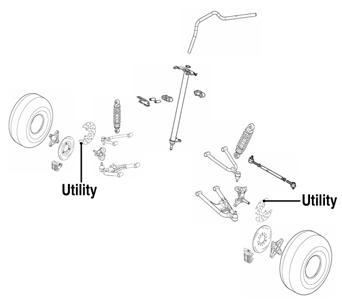
13 minute read
Suspension
The following suspension system components should be inspected periodically to ensure proper operation.
A.Shock absorber rods not bent, pitted, or damaged.
B.Rubber damper not cracked, broken, or missing.
C.Shock absorber body not damaged, punctured, or leaking.
D.Shock absorber eyelets not broken, bent, or cracked.
E.Shock absorber eyelet bushings not worn, deteriorated, cracked, or missing.
F.Shock absorber spring not broken or sagging.
Front and Rear Suspension Assembly Schematics
Utility
KM598E
KM463 KM462

Front Shock Absorbers
REMOVING 1.Secure the ATV on a support stand to elevate the wheels and to release load on the suspension.
2.Remove the cap screws and nuts securing each shock absorber to the A-arm and frame.
! WARNING
Make sure the ATV is solidly supported on the support stand to avoid injury.
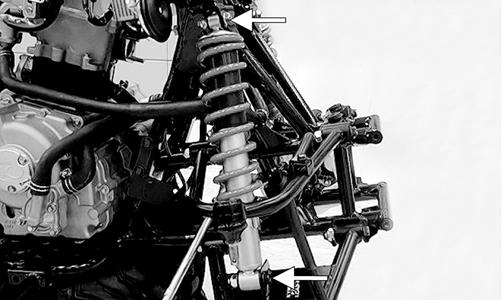
KM573A
CLEANING AND INSPECTING
NOTE: Whenever a part is worn excessively, cracked,
or damaged in any way, replacement is necessary.
1.Clean the shock absorbers in parts-cleaning solvent. 2.Inspect each shock rod for nicks, pits, bends, and oily residue. 3.Inspect the springs, spring retainers, shock rods, shock bodies, and eyelets for cracks, leaks, and bends. INSTALLING 1.Install each shock absorber to the frame and A-arm with cap screws and nuts. Tighten all nuts to 29 ft-lb.
CAUTION
Rear Shock Absorber
REMOVING 1.Secure the ATV on a support stand to elevate the wheels and to release load on the suspension. ! WARNING
Make sure the ATV is solidly supported on the support stand to avoid injury.
2.Remove the rear shield plate from the swing arm; then remove the lower shock mounting nut and cap screw.

KM551A
NOTE: Support the swing arm with a block of wood
or other support to allow removal of the cap screw.

KM555A
3.Remove the upper shock mounting nut and cap screw; then remove the shock absorber from the frame.

KM554
CLEANING AND INSPECTING 1.Clean the shock absorber in parts-cleaning solvent. 2.Inspect the shock absorber body, bottom stop, and rubber bushing for damage and leaking oil. If any defects are found, replace the shock absorber. 3.Inspect the spring, spring seat, and preload adjustment nuts and threads for damage or corrosion. If corrosion is present on the threads, clean with a fine wire brush and oil lightly.

KM561A
INSTALLING 1.Raise the swing-arm and place the shock absorber in position; then install the upper and lower cap screws and nuts. 2.Tighten the upper nut and the lower nut to 29 ft-lb. 3.Install the rear swing arm skid plate and four cap screws. Tighten securely. ADJUSTING SPRING PRELOAD The rear spring preload is adjustable by changing the spring set length. Using the following procedure, adjust the spring. 1.Loosen the lock nut (1). Adjust the spring preload by turning the adjuster (2) clockwise to increase spring preload or counterclockwise to decrease spring preload.

KM551B
2.Tighten the lock nut securely.
Swing Arm
REMOVING AND DISASSEMBLING For the Utility, see Rear Drive Axle in Drive System. For the DVX, use the following procedure. 1.Secure the ATV on a support stand to elevate the wheels and to release load on the suspension.
2.Remove the rear wheels; then remove the rear hub caps and hub nuts. Discard the cotter pins. 3.Remove the rear axle assembly (see Drive System); then remove the rear shock absorber. 4.Remove the cushion arm lock nut and cap screw; then remove the lock nut and cap screw securing the cushion arm link to the swing arm. Remove the cushion arm/link assembly. Account for three bushings.
! WARNING
Make sure the ATV is solidly supported on the support stand to avoid injury.

KM557A KM568A

5.Remove the axle housing (see Drive System). 6.Remove the brake hose guide clamp.
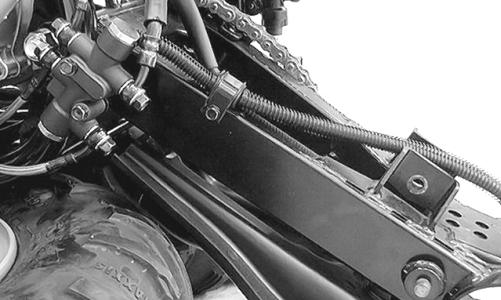
KM495
7.Remove the swing-arm pivot nut; then remove the swing-arm pivot flange bolt and remove the swing arm.

KM496
8.Remove the chain guide. 9.Remove the dust seals from the swing arm; then remove two bushings and the swing arm axle.
KM499B
4.Inspect the needle bearings for missing rollers, rust or corrosion, or flat rollers. Check for a tight fit in boss. Replace the arm if bearings are loose.


KM565
5.Inspect all dust seals and replace if they are cracked, torn, dried out, or loose.
KM500
10.Remove the lock nut and cap screw securing the cushion link to the cushion arm. Account for a bushing. CLEANING AND INSPECTING NOTE: Whenever a part is worn excessively,
cracked, or damaged in any way, replacement is necessary.
1.Inspect the dust seals, bushings, and pivot axle for wear or damage. If any defect is found, they must be replaced. 2.To inspect the swing arm and swing arm axle, place the swing arm axle and bushings in the swing arm; then using the flange bolt, rock the bushings and axle from side to side and up and down. If excessive play is noted, the bushings, axle, or swing arm must be replaced. Check for cracks or broken welds. 3.To inspect the cushion arm bushings, install the bushings in the cushion arm; then check for excessive play by rocking the bushing.
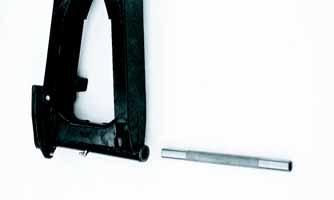

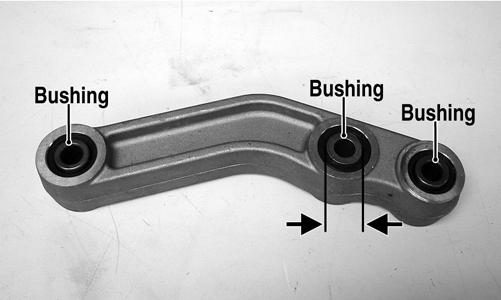

KM499B
KM564B
6.Inspect the drive chain and sprockets for excessive wear, chain stiffness, or rust/corrosion.
ASSEMBLING AND INSTALLING 1.Remove any nicks or burrs from the bearing bosses in the cushion arm with fine emory cloth; then using a suitable bearing installer, press new needle bearings into the end bosses of the cushion arm.

KM565A
2.If the bushing was removed from the middle boss of the cushion arm, press in a new bushing. NOTE: The bearings and bushing must be centered
in the bearing boss so the dust seals can be properly installed.
3.Using an appropriate seal driver, install the new dust seals in the cushion arm; then apply multi-purpose grease to the bearings, bushing, and dust seal lips. 4.Install the bushings in the cushion arm and cushion link; then connect the cushion link to the cushion arm with the flange cap screw and lock nut. Tighten securely.

KM568
5.Install the swing arm axle and bushings; then install the dust seals and lubricate the lips with grease. 6.Place the swing arm into position in the frame; then install the swing arm pivot cap screw and lock nut.
Tighten to 50 ft-lb.
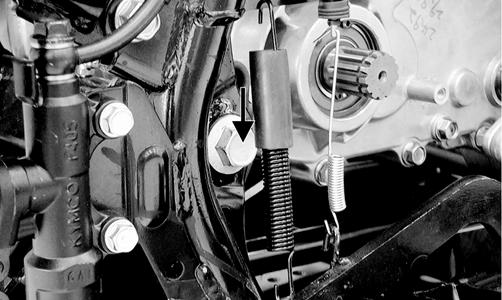
KM496A
7.Apply grease to the swing arm pivot through the grease fitting.

KM501
8.Place the cushion arm and cushion arm/link assembly into position and secure with the flange cap screws and new lock nuts. Tighten securely.

KM557A
9.Install the shock absorber and secure with the existing hardware. Tighten to 29 ft-lb. 10.Install the axle housing, axle, and brake assembly (see Drive System). 11.Install the drive chain and sprockets (see Drive System); then adjust the chain to specifications (see
Periodic Maintenance/Tune-Up). 12.Apply grease to the axle splines; then install the hubs and hub nuts. Tighten to 72 ft-lb.

KM468
13.Install new cotter pins; then install the hub caps and rear wheels. Tighten the lug nuts to 32 ft-lb.

KM469

KM464
14.Remove the ATV from the support stand.
Front A-Arms
REMOVING 1.Secure the ATV on a support stand to elevate the front wheels; then remove a front wheel.
2.Remove the hub cap; then remove the cotter pin from the nut. ! WARNING
Make sure the ATV is solidly supported on the support stand to avoid injury.

SP366
3.Remove the nut securing the hub. 4.Remove the cap screws securing the brake caliper; then remove the caliper and lay aside.

KM266A
5.Remove the hub assembly; then on the Utility, remove the disc cover.

KM569
6.Remove the cotter pin and slotted nut securing the tie rod end to the knuckle; then remove the tie rod end from the knuckle.

KM573
7.Remove the brake hose clamp from the A-arm; then remove the cotter pins and slotted nuts securing the upper and lower ball joints.
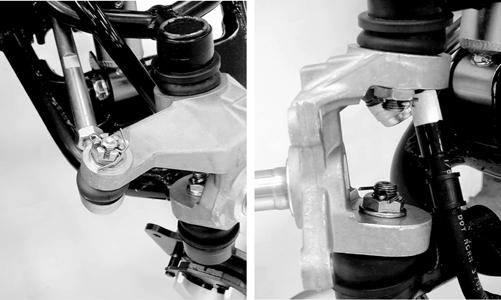
KM570
8.Remove the shock absorber mounting cap screws; then remove the shock absorber assembly. 9.Using a ball joint remover, remove the ball joints from the knuckle; then remove the front bumper. CLEANING AND INSPECTING NOTE: Whenever a part is worn excessively,
cracked, or damaged in any way, replacement is necessary.
1.Clean the knuckle in parts-cleaning solvent; then dry with compressed air. If any damage or excessive wear is detected, the knuckle must be replaced. 2.Inspect the ball joint for boot damage or wear.
Replace the A-arm if the ball joint is damaged or worn. 3.Inspect the arm for broken welds, cracks, or bends.
Replace if damaged. 4.Remove the bushings and dust seals and inspect for damage to seal lips and spacers. NOTE: The pivots are equipped with roller bearings.
The bearing rollers may fall out when the spacers are removed.
5.Check the bearings for excessive wear and replace them if worn. 6.Using a suitable bearing remover, remove the pivot bearings; then clean all parts in parts-cleaning solvent.

SP382
NOTE: All bearings, bushings, and seals that are
removed must be replaced with new ones.
INSTALLING 1.Install the bearings in the upper arm pivot to a depth of 13.6 mm (0.535 in.) with a bearing installer and suitable spacer.

ATV2196A
2.Coat the spacers and the lips of the dust seals with multi-purpose grease; then install them in the upper pivot. 3.Repeat steps 1 and 2 for the lower A-arm. 4.Clean all grease from the ball joint tapers and the knuckle bores; then install the arms to the steering knuckle and tighten the ball joint nuts to 22 ft-lb.
Install new cotter pins.

SP388A
NOTE: During assembly, new cotter pins should be
installed.

SP390
5.Install the arms to the frame with the pivot cap screws; then tighten the nuts to 32 ft-lb.

KM579
6.Install the front bumper assembly; then install the front shock absorbers. Apply red Loctite #271 on the cap screw threads and tighten to 29 ft-lb. 7.On the Utility, apply red Loctite #271 to the mounting cap screws; then install the disc cover and tighten securely.

KM569
8.Connect the tie rod ends to the steering knuckle; then tighten the nut to 15 ft-lb and install a new cotter pin. NOTE: During assembly, new cotter pins should be
installed.

KM581
Wheels and Tires
TIRE SIZE
! WARNING
Use only Arctic Cat approved tires when replacing tires. Failure to do so could result in unstable ATV operation.
The ATV is equipped with low-pressure tubeless tires of the size and type listed. Do not under any circumstances substitute tires of a different type or size. ! WARNING
Always use the size and type of tires specified. Always maintain proper tire inflation pressure.
! WARNING
Do not mix tire tread patterns. Use the same pattern type on front and rear. Failure to heed warning could cause poor handling qualities of the ATV and could cause excessive drive train damage not covered by warranty.
TIRE INFLATION PRESSURE Tire inflation pressure should be as specified. REMOVING 1.Secure the ATV on a support stand to elevate the wheels.
! WARNING
Make sure the ATV is solidly supported on the support stand to avoid injury.
2.Remove the wheels. NOTE: Keep left-side and right-side wheels sepa-
rated for installing them on their proper sides.
CLEANING AND INSPECTING
NOTE: Whenever a part is worn excessively,
cracked, or damaged in any way, replacement is necessary.
1.Clean the wheels and hubs with parts-cleaning solvent. 2.Clean the tires with soap and water.
3.Inspect each wheel for cracks, dents, or bends. 4.Inspect each tire for cuts, wear, missing lugs, and leaks. INSTALLING 1.Install each wheel on its hub.
NOTE: Make sure each wheel is installed on its
proper hub as noted in removing (the “rotation arrow” must indicate forward direction of rotation).

AF612D
2.Tighten to 32 ft-lb. CHECKING/INFLATING 1.Using an air pressure gauge, measure the air pressure in each tire. Adjust the air pressure as necessary to meet the recommended inflation pressure. 2.Inspect the tires for damage, wear, or punctures. ! WARNING
Do not operate the ATV if tire damage exists.
NOTE: If repair is needed, follow the instructions
found on the tire repair kit or remove the wheel and have it repaired professionally.
NOTE: Make sure all tires are the specified size and
have identical tread pattern.
3.Check the front wheel toe-in and toe-out and adjust as necessary (see Steering/Frame). 4.Test drive the ATV on a dry, level surface and note any pulling to the left or right during acceleration, deceleration, and braking. NOTE: If pulling is noted, measure the circumfer-
ence of the front and rear tires on the pulling side. Compare the measurements with the tires on the opposite side. If pulling is noted during braking only, check and adjust the brakes as necessary and recheck operation (see Periodic Maintenance/TuneUp).
5.Increase the air pressure in the tires with the smallest circumference measurement until all tires are equal in circumference. 6.Repeat steps 4-5 as necessary to ensure proper handling.
Troubleshooting
Problem: Suspension too soft Condition Remedy
1. Spring(s) weak 1.Replace spring(s) 2. Shock absorber damaged 2.Replace shock absorber
Problem: Suspension too stiff Condition Remedy
1. A-arm-related bushings worn or binding 1.Replace bushing
Problem: Suspension noisy Condition Remedy
1. Cap screws (suspension system) loose 1.Tighten cap screws 2. A-arm-related bushings worn 2.Replace bushings
Problem: Rear wheel oscillation Condition Remedy
1. Rear wheel hub bearings worn - loose 1.Replace bearings 2. Tires defective - incorrect 2.Replace tires 3. Wheel rim distorted 3.Replace rim 4. Wheel hub cap screws loose 4.Tighten cap screws 5. Axle shaft nut loose 5.Tighten nut 6. Auxiliary brake adjusted incorrectly 6.Adjust brake 7. Rear suspension arm-related bushing worn 7.Replace bushing 8. Rear shock absorber damaged 8.Replace shock absorber 9. Rear suspension arm nut loose 9.Tighten nut




